‘Where?!?’ ‘You mean Turkey?’ ‘Is that even a real country?’ These questions are, well, not entirely unjustified. Turkmenistan is one of the world’s least visited countries, being number 7 on that list. To put that in perspective, North Korea and Afghanistan both get more tourists.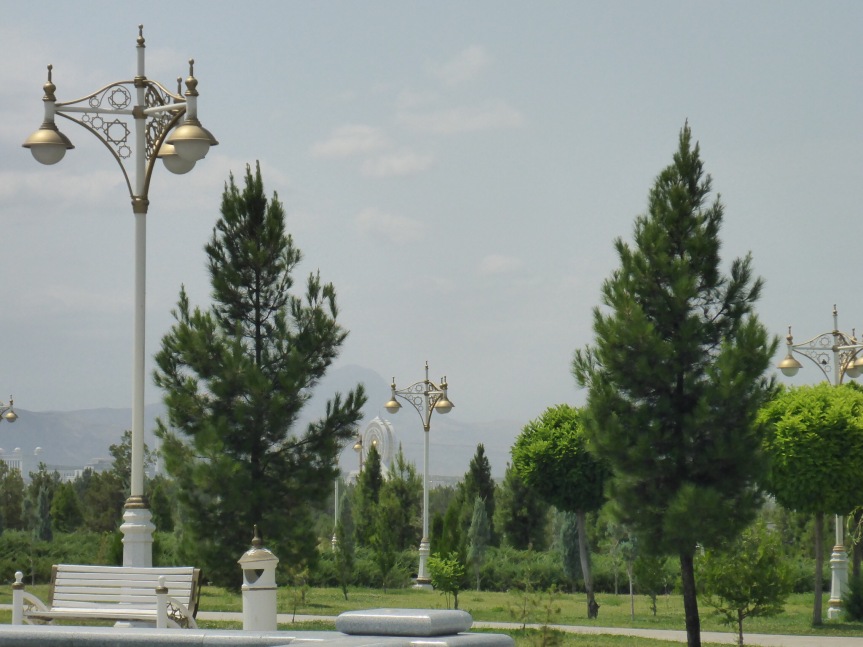
Above: A park in Ashagabat, with the world’s largest indoor ferris wheel in the background.
Several times throughout my trip in Turkmenistan I had to ask myself the latter question, because at times I wasn’t sure. For those of you who don’t know much about Turkmenistan (well, who does?), this should get you up to speed. The country borders Russia, Iran, Kazakhstan, Uzbekistan and the Caspian Sea, and is made up of several tribes who previously roamed the Karakum Desert. While the Silk road was still a major trade route, several of its cities were some of the most important in the world, such as Kunye Urgench and Merv. Passed between several khanates, invaded by Mongols, and conquered by Tamarland, it was finally captured by Russia. Now, it has an eccentric dictator Gurbanguly Berdimuhamedow – don’t worry, only Turkmens can pronounce it. He rose to power after being the personal dentist of his predecessor Niyazov, an equally eccentric man who loved his mother so much that he renamed bread and April after her. Yup, that’s right, Google it. And that’s probably the most important thing for you to understand about Turkmenistan – logic isn’t always obvious!
My first experience of Turkmenistan was being stuck out at sea, which somewhat marred my initial impressions of the place. (Read about my experience here.) After that, I will admit I was probably still tinged with cabin fever and exhaustion, and couldn’t fully appreciate the strangeness that is Ashgabat.
Ashgabat is apparently the city of love. One look at the place, not knowing anything about it, and you wonder if they named it ironically. These days, it should be named ‘White Marble City,’ since every building is made of marble – or white plastic when they ran out of money. Several times, myself and fellow travellers have struggled to describe it, because it’s so unique in such an eerie and bizarre way that it’s hard to convey just what it is like to someone who hasn’t visited.
The best I could come up with is that it reminded me of the Truman Show. Everything looks the same. The super market looks the same as a public toilet building; everything is white, and might have gold painted eaves for decoration at most. There are perfectly manicured parks, statues and monuments every few blocks, and wide (but empty) roads. And the weirdest thing is that there are no people. No one walked the streets. The only people outside were the gardeners and street cleaners, and the military guards posted at statues and monuments. It just doesn’t feel like a real city.
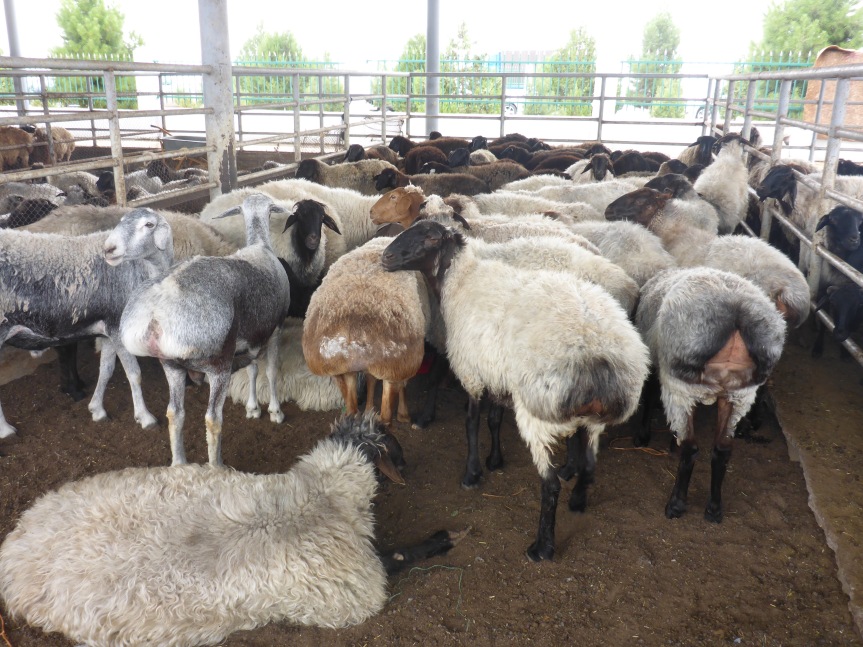
We visited the market in Ashgabat, and actually discovered some people. This used to be the local livestock market, but now has been rebuilt into a massive complex of aircraft hangars filled with stalls. There was everything from fruit, rugs and camels, to generic plastic junk from China. It was impressive in its size, but it is no longer the traditional-style market it had been just a few years earlier. Looking back, although it was the first fat-bottomed sheep I got to see, I think it was possibly more amazing we found some local Turkmen people not behind white marbled doors!
We were given a quick bus tour of the city, and shown most of Ashgabat’s main buildings. We weren’t allowed to stop at those buildings, only take photos from inside the bus. The sites we could get out at was a statue No. 34 of current Mr Unpronounceable, and the that mosque Niyazov the Bread Renamer built in his own honour.
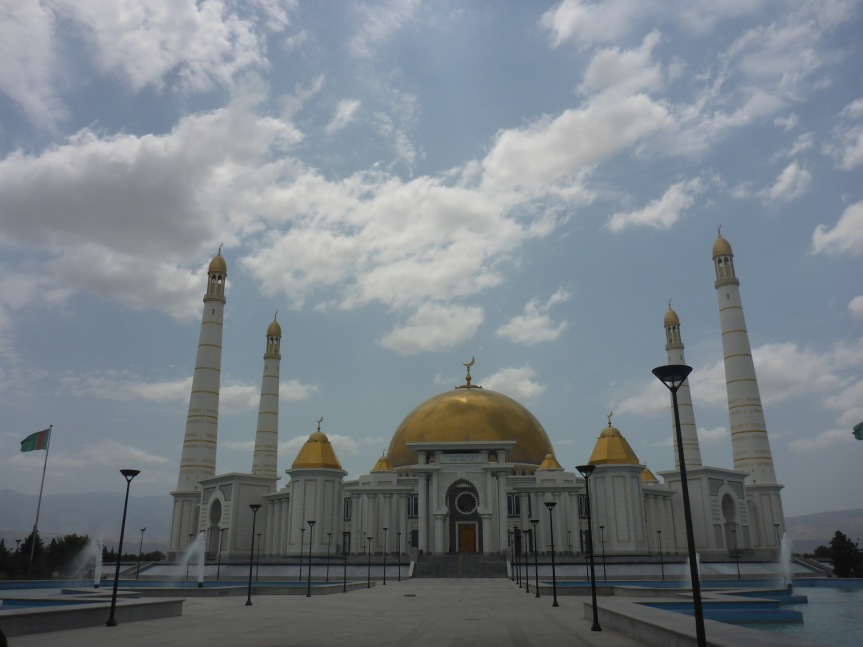
This mosque is unique. It is the world’s only mosque which has non-Arabic script used for decoration. Our guide was quite proud to point out that this inflamed several ‘more conservative clerics,’ and I would have to admit it did sound like a brave and perhaps more modern thing to do. However, former President Niyazov has actually covered the mosque with quotes, not from the Quran, but from his own book. Both inside at out, nationalistic phrases about Turkmenistan and its former leader replace those that might otherwise have been about Allah. I don’t think it was the language that offended.
Turkmenistan essentially has one east to west road that stretches across the country. This has been very poorly maintained – but don’t worry, they’re building a brand new one right next to it. Of course, in Turkmen style, instead of doing the logical thing of working at this project in continuous sections, bit by bit, they’ve got brand new road dotted throughout the country. There would be about 5 km of new road, and then it would abruptly stop (which we knew, because they’d put a mound of dirt there), then it would be back to the old road for about twenty more kilometres, before coming across another 5km of new road. We’d have to drive off the road, through dust and ditches, to switch lanes all the time.
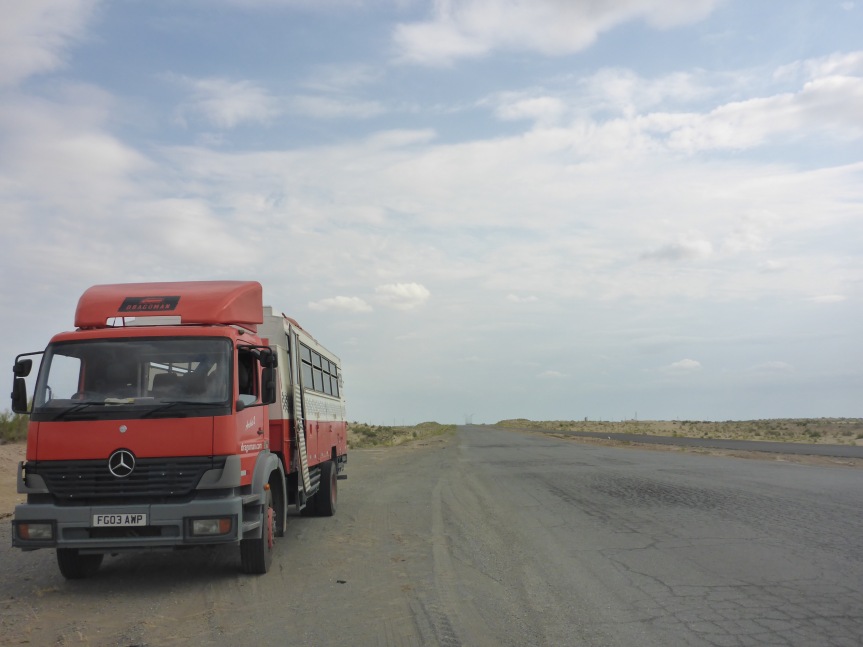
One hilarious point had two bridges. The old one was broken, and our guide proudly proclaimed the newer more modern one ‘a beautiful Turkmen bridge.’ Only problem was, the road (well both of them) led to the old one, and no one had thought to solve that problem. So we had a bridge, but no road. The truck clambered off the road, down the ditch, and lined up to what was essentially some sort of Moto GP or dirt biking ramp. Some serious driving skills were needed, and if we didn’t already know it from the occasional deep pot-holes, vehicle suspension was now appreciated even more.
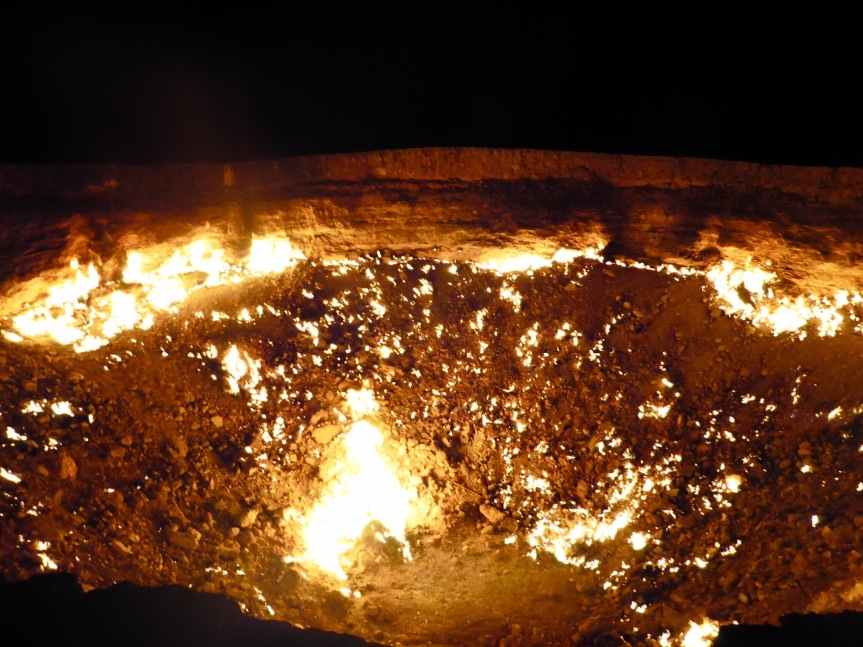
The definite highlight of the country is the Darvaza (also Darwaza) gas crater. The crater is in the middle of the desert, and we got to camp near by. In the 40s, the Russians were building a gas pipeline, and accidentally hit a seam of gas while building it. Thinking it would burn out in about 2 days, they decided to throw a match in, and then continue building when it had burns itself out. Instead, it’s still burning about 70 years on, and it’s a fearsome sight. It’s best appreciated at night, when the flames stand out more. You feel the heat before you see anything, and the closer you get the size of it impresses more.
While writing about this Silk Road trip, I find myself constantly using the phrase ‘it wasn’t what I expected.’ So, I’ll use it here again. The kamakazi locusts were not what I expected. At times, they made appreciating the impressive flames of the crater hard to enjoy, because there were thousands of the things flying everywhere, crawling over our feet, landing on shoulders, and flying straight into the crater. It was such a bizarre thing to see! These locusts would fly towards the light, get caught in the hot air above, and most would drop dead before they even realised they were in danger. Some managed to turn around and land near the edge of the crater – before realising they couldn’t climb out. Very few seemed to survive at all. I wondered what effects this phenomenon had on the local ecosystem, and if this was some freak occurrence that day or a year round event.
Our last stop before heading into Uzbekistan was Kunye Urgench. This city used to be in Kwarezm, a khanate that included parts of modern day Uzbekistan, Kazakhstan and Turkmenistan. Due to the surrounding deserts and more hostile climates, it was an important stop along the Silk Road, which is how it acquired its wealth. The city rivalled Bukhara in its heyday, but was devastated in the 13th century when the Mongols came through and massacred many living there. The city rebuilt, but when Timur captured it, they rebelled several times against the Uzbek conquerer. This resulted it the city being raized, leaving the few remnants at the site today. The buildings have not had much attention to them paid, and were one of the best examples I saw of original, untouched and unrestored history. It gave me an appreciation of how much work must go into restoration, and what an important thing it is to look after sites such as these.
Sadly, I didn’t get to see much of Kunye Urgench, because I managed to get heat stroke (and throw up in a rose bush near the entrance). I did get to see the first building, which was one of the few with art still remaining on its walls. Regardless, it’s inspired me to look into the history of Kwarezm to find out more about what I missed seeing.
Turkmenistan is not my favourite country. I will admit that I didn’t enjoy it as much as most other tavellers in our group, who had a slightly more relaxing week. (Due to the 5 days at sea, the long drive into Ashgabat to catch up to schedule, being quite tired from our 2.30am arrival and not having a lot of energy to site-see Ashgabat, summer temperatures of 40 degrees and above – I did of course choose to come here in summer, my fault there! – some bumpy roads which I blamed for my nausea, managing to give myself heatstroke – turns out the roads weren’t actually that bad! – and finally, being too sick to appreciate Kunye Urgench.) But, it was certainly an eye opener! And that’s why I chose to travel the Silk Road, to learn from the countries I had no clue about. The country’s oddities have stuck with me, and I find myself talking about this place more than any other country I visited. Turkmenistan seems to have an entirely different way of doing things, from roads to politics, and I could never believe a place like it existed unless I’d visited.
So no, it’s not Turkey. And yes, somehow, it is a real place.
I travelled with Dragoman, one of the few companies who take travellers through the 7th least visited nation in the world. You can visit Turkmenistan on the Tbilisi-Ashgabat legs, or the Ashgabat-Tashkent leg. Due to current issues with visas, it’s best to travel on a tour such as this, as it is the easiest way to get a visa there nowadays!

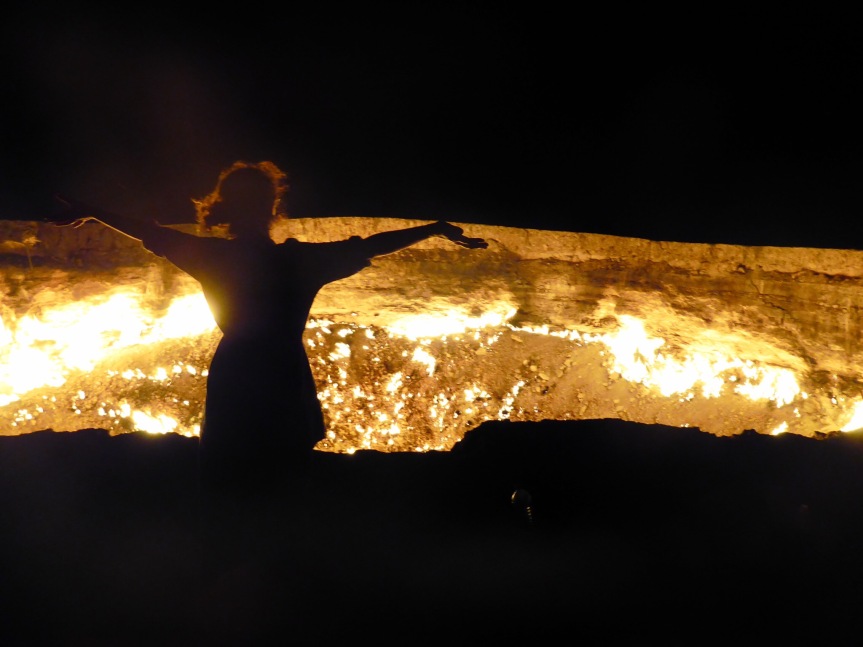


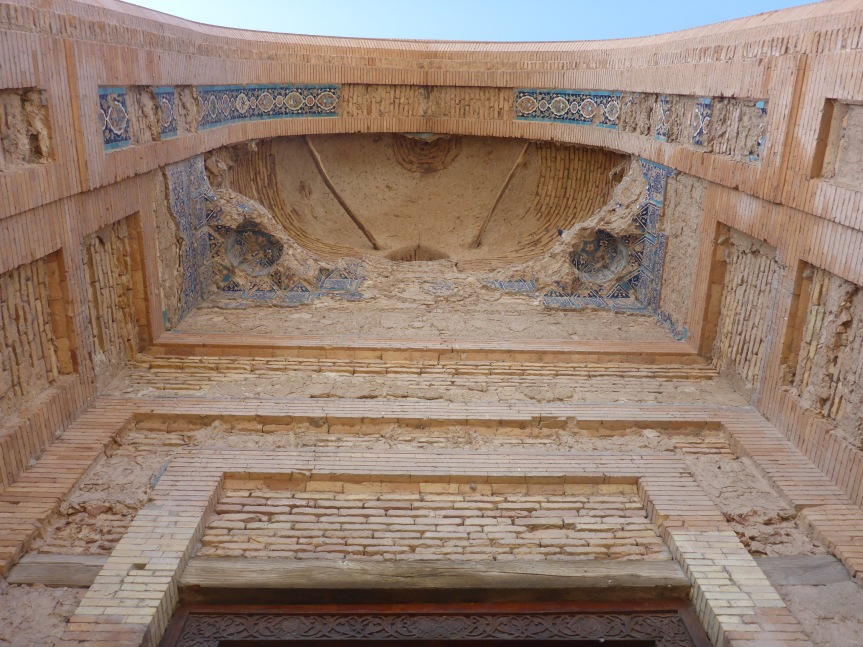
Very interesting post.
LikeLike